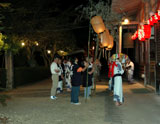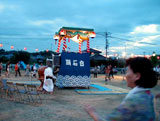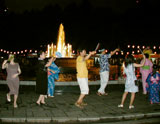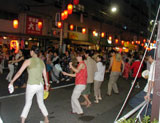The image of the site of modern Bon Dancing would be the school ground of elementary or junior highschools or the open space of the public halls.
However, if we look at the case examples of the Bon Dancings nationwide and historical Bon Dancings, we are surprised to know that places which are alien to these modern images and various locations are used as the venue for Bon Dancing.
The variety of the dancing venue
In the first place, we would like to recount the types of the locations where Bon Dancings are held (Refer to the chart below). This is not a cyclopedic chart, but we think that you can get the image of in what kind of places the Bon Dancings are danced.

The chart above indicates modern Bon Dancings, traditional Bon Dancings, and Bon Dancings found in the recordings, all together in the same chart.@
It is immedeately obvious that the type of locations where the Bon Dancings are danced are extremely variable. And we can realize that traditional Bon Dancings have greater diversity of spaces than modern Bon Dancings.*
The following are the simple explanations on each types of spaces.
* Please note that Bon Dancings that we cited as the typical examples of certain type sometimes also applies to other types. For instance, Niino Bon Dancing is held in a “fair” and at the same time “on the street”. Totsukawa Bon Dancing is presently held in a gymnasium of a junior highschool, but there were times when they danced in the riversides and religious halls. As just described, the space of one Bon Dancing cannot be categorized into only one type. On the contrary, we would like to direct our eyes carefully to the diverseness, historicity, and the richness of Bon Dancing.
Religious space
In the traditional Bon Dancings, the precincts of the temples of the local communities are frequently used. The cases that they use precincts of the shrines are not uncommon. During and before the Meiji Era, the sycretization of Shinto and Buddhism was common in Japan, so they thought nothing of dancing Bon Dancing, the Buddhist event, in the precincts of shirines.
Also, in the old times, there were many small religious monuments in all around the localities such as small shrines, stone statues, Inari statues, and functioned as a place of religious faith for the local residents. The front space of these spiritual spots in the localities were also frequetly used as dancing sites.
In front of the main building of Zenkohji Temple, the site of Futto Bon Dancing (Nembutsu Dancing) (Toei-cho Aichi Pref. 2004, August 14)
Waterfront space
“Waterfront spaces” are frequently seen as spaces in nature.
In the old times, the other side of the oceans and rivers were considered to be connected to another world. The waterfront is a place where various events such as Shouryou Nagashi (An event to send the spirits off by flowing religious offerings and lanterns to the river and/or ocean in the early evening on the 15th of Obon or early morning on the 16th of Obon) are held, and it is a very important space for Obon.*
At the same time, it was also a place where people felt it necessary to dance the dance to repose the spirits of the dead for it was a place where drowned bodies are washed ashore.
The spatial extent of the seashore and riverside could be considered to be suited as a location to hold Bon Dancing.
As a different sort of example, there are “on the ship (Uwajima Isa Odori: Ehime Pref.)”, and “on the bridge (Niigata), but these could also be categorized as waterfront spaces in a broad sense.
The dancing venue of Shiraishi Dancing is an open space by the beach.
*There is a religious belief to “water” in both Obon and Tanabata. In “Zokushin no Kosumorojih (The cosmology of popular belief) written by Naoki Yoshinari and published by Hakusuisha”, we can read “Does the Wakamizu (An event to bear water from a well and offer it on the household altar on the New Year’s Day. Or the water that is offered on this occasion) of Summer exist ?”. This text closes in to the foundation course of Obon and it is written after the field survey in southern Shikoku.
Spaces on the road
“Awa Dancing”, “Gujo Dancing”, “Nishimonai Bon Dancing”, “Owara Bon of the Wind”. If we enumerate, we notice that many famous Bon Dancings around the country are held on the streets.
If we attempt to count, approximately 2/3 of the traditional Bon Dancings that we have visited until the year 2004 used streets as dancing sites. We can say that streets are one of the most basic dancing sites of Bon Dancings.
Especially, the intersection part of the streets are called “Tsuji”. This is a place where there is more traffic than ordinary streets. In the old times, there were various folk customs such as “Tsuji Nembutsu” and “Tsuji Ura”, and the intersection seemed to have been considered as a kind of “wonder space”.
*In the dancing sites of the street space, the problem of the coordination between the traffic and the dance also comes up.
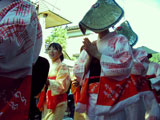
Street strolling of Owara Bon of the Wind (Yatsuo, Toyama Pref. 2002/9/1)
*To perform augury, you stand on the intersection of the street and bear in mind the things you want to know, and you judge by the contents of the first word you heard.
Public Facilities
Public facilities such as “Schools”, “Community Centers”, and “Parks” are the places where they are frequently used in modern Bon Dancings, and they are also frequently used in traditional Bon Dancings. It could be said that they are new Bon Dancing spaces which were found during and after the modern era.
There are examples of historical “public facilities”. For instance, the Niijima Bon Dancing was danced in the garden of the administrative institution of the local governor of the island. In western Japan, the assembly hall of mura was also frequently used as dancing sites.
Marunouchi Ondo (Marunouchi Dance Song), “the original Tokyo Ondo” make a comeback in Hibiya Park (Chiyoda Ward, Tokyo 2004/8/7)
Semipublic Space (factories, commercial space, etc.)
Although it is not a very accomplished expression, we attempt to call the premises of the companies and commercial spaces, “semipublic space”.
Factories were also places where many young female workers gathered before the WW 2, and they are spaces which made great contributions to the development and diffusion of the Bon Dancing culture of the modern era.
In the business castletowns, many companies provided the premises of the factories for the Bon Dancing sites of the local communities to work for the good of the communities.
“Fairs” are also interesting spaces. In the famous Niino Bon Dancing, the streets which are dedicated to the Ishigamisama (Gods which were enshrined in the places where fairs are held, since the ancient times) become the dancing sites, and at the start of Bon Dancing, people pay their respects by praying Ichigami-wasan (A prayer to psalm the god of the fair). The fair where many strangers gather and have business transactions was a special space for people of the old times. Jishu sect of Buddhism which popularized Odori Nembutsu (Nembutsu folk dances) also frequently chose these fairs as dancing sites and bases of their religion. “The fair” of the modern times could be the commercial avenue. Bon Dancing of summer nights are enjoyed in a lot of commercial avenues.
Kawachi Ondo (Kawachi Dance) convention which is the established custom of Kinshicho commercial avenue. (Kinshicho 2004/7/18)
Residence
The residence of individuals are also making an area as a dancing site of Bon Dancing.
There are cases that people dance in the houses of the influencial men of the local region such as houses of the pioneers of the village and/or the houses of village headmen, but what is important is the case that people dance in the places such as gardens of the houses of the families of Niibon. This custom is distributed throughout the Japanese archipelago, and it is also a historically old custom.
In the famous Damine Bon Dancing, people of the village visit the houses of Niibon and dance “te-odori (hand dance)” (the so-called Bon Dancing) following the high-pitched Nembutsu folk dance (“Hanekomi”) by the young people and console the soul of the new spirits.
In the case of residents, there are differences such as “dance in front of the gate”, “dance in the garden”, “go into the parlor and dance”.

